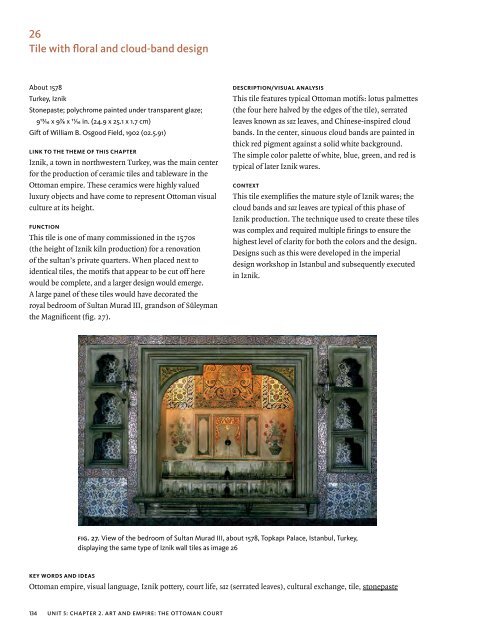Courtly Splendor in the Islamic World - The Metropolitan Museum of ...
Courtly Splendor in the Islamic World - The Metropolitan Museum of ...
Courtly Splendor in the Islamic World - The Metropolitan Museum of ...
Create successful ePaper yourself
Turn your PDF publications into a flip-book with our unique Google optimized e-Paper software.
26<br />
tile with floral and cloud-band design<br />
About 1578<br />
Turkey, Iznik<br />
Stonepaste; polychrome pa<strong>in</strong>ted under transparent glaze;<br />
913⁄16 x 9⅞ x 11⁄16 <strong>in</strong>. (24.9 x 25.1 x 1.7 cm)<br />
Gift <strong>of</strong> William B. Osgood Field, 1902 (02.5.91)<br />
l<strong>in</strong>k to <strong>the</strong> <strong>the</strong>me <strong>of</strong> this chapter<br />
Iznik, a town <strong>in</strong> northwestern Turkey, was <strong>the</strong> ma<strong>in</strong> center<br />
for <strong>the</strong> production <strong>of</strong> ceramic tiles and tableware <strong>in</strong> <strong>the</strong><br />
Ottoman empire. <strong>The</strong>se ceramics were highly valued<br />
luxury objects and have come to represent Ottoman visual<br />
culture at its height.<br />
function<br />
This tile is one <strong>of</strong> many commissioned <strong>in</strong> <strong>the</strong> 1570s<br />
(<strong>the</strong> height <strong>of</strong> Iznik kiln production) for a renovation<br />
<strong>of</strong> <strong>the</strong> sultan’s private quarters. When placed next to<br />
identical tiles, <strong>the</strong> motifs that appear to be cut <strong>of</strong>f here<br />
would be complete, and a larger design would emerge.<br />
A large panel <strong>of</strong> <strong>the</strong>se tiles would have decorated <strong>the</strong><br />
royal bedroom <strong>of</strong> Sultan Murad III, grandson <strong>of</strong> Süleyman<br />
<strong>the</strong> Magnificent (fig. 27).<br />
key WorDs anD iDeas<br />
134 unit 5: chapter 2. art and empire: <strong>the</strong> ottoman court<br />
Description/Visual analysis<br />
This tile features typical Ottoman motifs: lotus palmettes<br />
(<strong>the</strong> four here halved by <strong>the</strong> edges <strong>of</strong> <strong>the</strong> tile), serrated<br />
leaves known as saz leaves, and Ch<strong>in</strong>ese-<strong>in</strong>spired cloud<br />
bands. In <strong>the</strong> center, s<strong>in</strong>uous cloud bands are pa<strong>in</strong>ted <strong>in</strong><br />
thick red pigment aga<strong>in</strong>st a solid white background.<br />
<strong>The</strong> simple color palette <strong>of</strong> white, blue, green, and red is<br />
typical <strong>of</strong> later Iznik wares.<br />
context<br />
This tile exemplifies <strong>the</strong> mature style <strong>of</strong> Iznik wares; <strong>the</strong><br />
cloud bands and saz leaves are typical <strong>of</strong> this phase <strong>of</strong><br />
Iznik production. <strong>The</strong> technique used to create <strong>the</strong>se tiles<br />
was complex and required multiple fir<strong>in</strong>gs to ensure <strong>the</strong><br />
highest level <strong>of</strong> clarity for both <strong>the</strong> colors and <strong>the</strong> design.<br />
Designs such as this were developed <strong>in</strong> <strong>the</strong> imperial<br />
design workshop <strong>in</strong> Istanbul and subsequently executed<br />
<strong>in</strong> Iznik.<br />
Fig. 27. View <strong>of</strong> <strong>the</strong> bedroom <strong>of</strong> Sultan Murad III, about 1578, Topkapı Palace, Istanbul, Turkey,<br />
display<strong>in</strong>g <strong>the</strong> same type <strong>of</strong> Iznik wall tiles as image 26<br />
Ottoman empire, visual language, Iznik pottery, court life, saz (serrated leaves), cultural exchange, tile, stonepaste

















